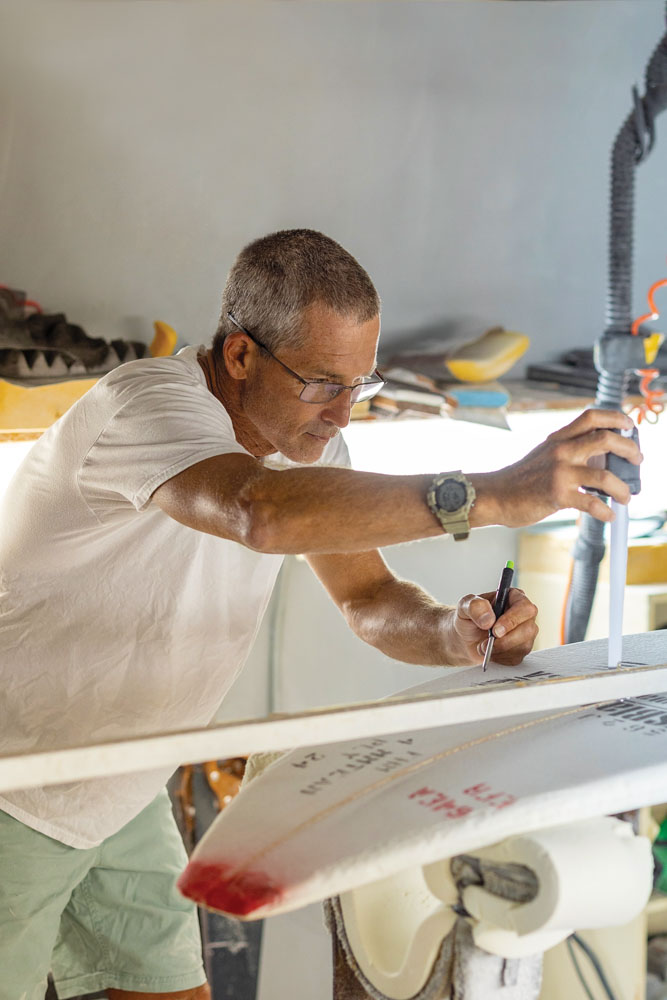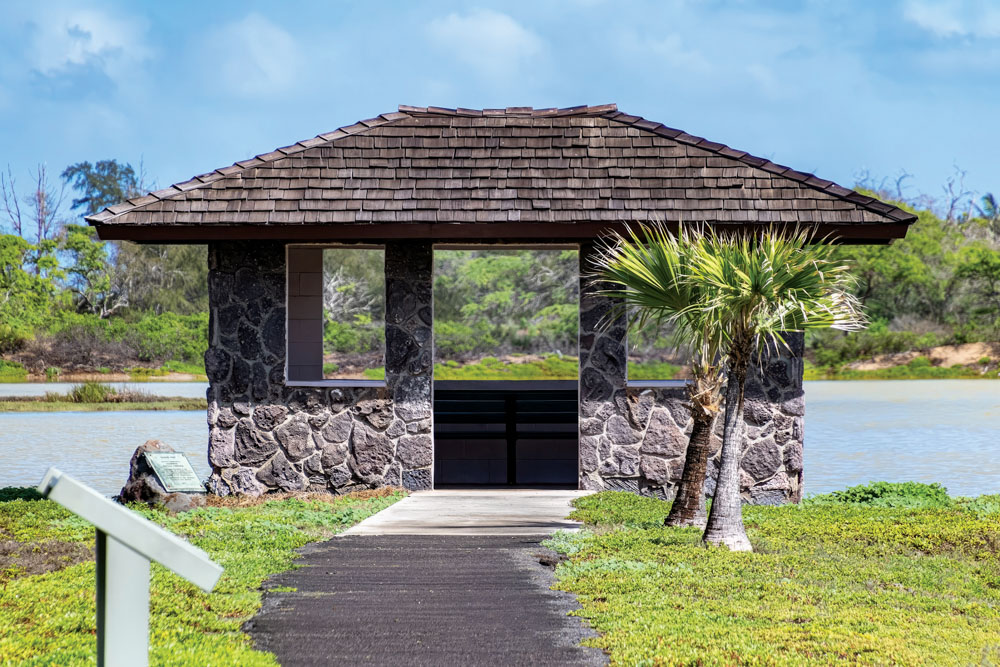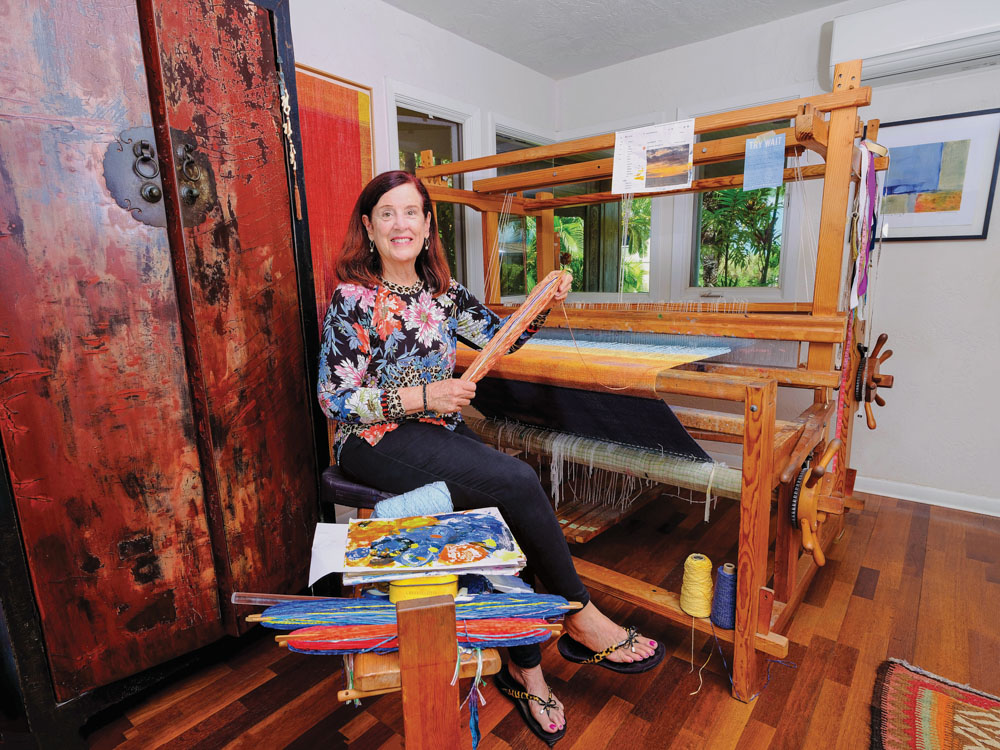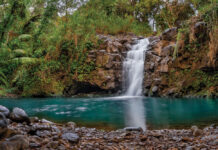Shaping Generations
The legacy behind the popular Maui surfboard brand, Kazuma Surfboards Hawai‘i.
By Serene Gunnison

When Matt Kazuma Kinoshita was a teenager, he was heading for a successful career as a professional surfer. During his days as a top-level competitor, Kinoshita clinched the coveted U.S. Surfing Championship and represented Hawai‘i on an international level at the World Surfing Championships. But around age 20, Kinoshita’s professional aspirations did a 180, as he shifted his focus from surfing to surfboard shaping.
The catalyst for this change was a man named Ben Aipa, his surfing coach who offered Kinoshita formal training in surfboard shaping. Aipa, who passed away in early 2021, is known as one of the greatest Hawaiian surfboard shapers of all time. In the early 1970s, Aipa invented the swallow tail and split tail designs. These newfangled creations awakened a high-performance surfing revolution, which took the sport to new heights and earned the legendary shaper a place in surfing’s Hall of Fame in 1992.
Ben Aipa didn’t offer his tutelage to just anybody, and to be taken under his wing was one of the highest privileges a budding shaper could achieve. “Surfboard shaping was once a secret society that was impossible to get into,” Kinoshita said. “To be formally trained by master Ben Aipa was unheard of and I was so honored and privileged to get his training.”
After absorbing Aipa’s esteemed shaping formula, known as the “Aipa Method,” Kinoshita went on to found Kazuma Surfboards Hawaii, one of Maui’s most recognizable surfboard brands. In the late 1990s, Kinoshita opened the Kazuma Surf Factory in a weathered green building in Pauwela.
The space is a veritable surfboard candy shop. Dozens of unridden surfboards line the showroom walls, tempting surfers who enter to whip out their credit card and leave with a brand-new stick. The sounds and scents of a working surfboard factory drift from the room next door, and surfers waiting on a custom board can peer into the production facility and watch their board being built in real time – a novelty in the surfboard shaping world.
While Kinoshita has found immense success as a surfboard shaper, he also dabbles in coaching, just as Aipa once did. Kinoshita helped kickstart the careers of several eminent Maui surfers, such as Dusty Payne, Ian Walsh and Imaikalani deVault. Now, Kinoshita is focused on perpetuating the Aipa Method and passing his knowledge on to upcoming shapers. He currently mentors 250 shapers around the world, virtually helping them improve their shaping and business skills.
As Kinoshita edges toward retirement, he wants to transition production to lower volume custom builds, focusing more on high-quality, personalized surfboards. A few years from now, the Kazuma showroom might not be packed with stock boards like it is today, and Kinoshita’s shapes may become more elusive. But while the proverbial changing of the guard is inevitable, Kinoshita has made sure that Aipa’s legacy – and his own – will endure.
Kanaha Pond Wildlife Sanctuary
Beyond its chain-link borders and public misconceptions is a flourishing native habitat.
By Serene Gunnison

Kanaha Pond Wildlife Sanctuary is a model Hawaiian wetland teeming with endemic plants and endangered native birds. Yet Kanaha Pond is often thought of as a stinky, swampy wasteland, thanks to the pond’s unfortunate neighbors – an industrial area, Kahului Airport and the Kahului Wastewater Treatment Plant, which is responsible for the unpleasant smell that envelopes the pond on windy days. But the bad reputation for Kanaha is just an illusion.
Beyond the sanctuary’s chain-link borders, you’ll find a prosperous wetland with a rich yet tumultuous history. Wetlands once stretched from present-day Kahului Airport to the Queen Ka‘ahumanu Center. In addition to providing habitat for myriad native species, these wetlands supported two royal loko pu‘uone, inland fishponds believed to have been built by King Kapi‘iohookalani in the late 1700s.
By the early 20th century, most of Kahului’s wetlands had disappeared – filled in or dried out to make room for development. Kanaha Pond was spared, though not entirely. When Kahului Harbor was dredged in 1910, portions of the pond were filled in with the material from the dredging. The area was further altered in the 1940s when a Naval Air Station was constructed in the northeast corner of the pond.
Despite the diminishing habitat and increased human activity, the pond remained a magnet for birds from near and far. In 1952, the pond’s significance as a waterbird habitat was recognized, and Kanaha Pond was formally designated as Hawai‘i’s first wildlife refuge. Twenty years later, the Department of the Interior named Kanaha Pond a National Natural Landmark.
Today, Kanaha Pond is managed by Hawai‘i Division of Forestry and Wildlife and is acknowledged as a vital habitat for federally endangered native birds like ae‘o (Hawaiian stilt). Only 1,000-2,000 Hawaiian stilts remain, but these long-legged natives are found at Kanah Pond in abundance. Other native “regulars” include ‘auku‘u (black crowned night heron) and ‘alae ke‘oke‘o (Hawaiian coot).
In the winter months, bird numbers at the sanctuary can skyrocket into the thousands, as yearly migrants such as the kolea (Pacific golden plover) arrive in Hawai‘i en masse. Other migratory birds thrown off course may rest at Kanaha before resuming their journeys, like Canada geese and the occasional curlew. Forestry and Wildlife employees also report seeing marsh hawks, peregrine falcons, nene (Hawaiian geese) and even great blue herons.
Although Kanaha Pond Wildlife Sanctuary has been protected for the better part of a century, the work to safeguard the pond’s wildlife and habitat is ongoing. The DOFAW is currently installing a predator- proof fence around the entirety of the sanctuary to keep nesting birds safe from rats, cats, mongooses and dogs. Once the fence is complete, DOFAW will reopen the sanctuary’s public access trail off Amala Place, though it closes seasonally from Aug. 31 to March 31 for the breeding season.
Next time you drive past Kanaha Pond, try to see it for what it is: a healthy, spring-fed wetland that supports some of Hawai‘i’s last remaining waterbirds. If you’re lucky, you’ll spot groups of ae‘o balancing precariously on their long pink legs, or maybe a mighty ‘auku‘u resting stoically nearby. This sanctuary and the protected wetlands inside its fences host thousands of flying friends, especially over the winter. Guests to the pond include endangered native birds like the Hawaiian stilt.
Nicole Seward Threading Maui
Textile artist Cathy Detrick reflects the sea and sand.
by Mona de Crinis

A white canvas made of silky yarn awaits textile artist Cathy Detrick in her South Maui home. Stretched on a loom that takes up almost an entire ocean-view room, the yarn has been pulled, the tension perfect, and the fabric paint and bright bolts ready. A photo, sketch or watercolor positioned near the loom guides the artist as she meticulously works her magic from the bottom up.
“For wall hangings, I start with all-white chenille or silk threads and paint them as I go, moving up the piece,” Detrick describes. “Starting at the bottom, which might be ocean, sand or land, I work up.” Capturing Maui’s mercurial sky can be challenging, Detrick said. “It’s always changing, never the same twice.”
With several looms going at once, she shifts focus between ongoing projects, allowing space for her artistry to breathe when faced with the occasional block. Long morning swims and snorkel sessions with her husband help quicken the blood, fire the imagination and quell the static of 24-hour news cycles and other modern distractions. “To live in that undersea world, however briefly, with turtles, octopuses and all kinds of amazing fish inspires me greatly,” she said.
Acclimating to island life took a few years, Detrick admits. Moving to Maui in 1999 from New England, where she enjoyed a flourishing career on Cape Cod, was a leap of faith for the professional artist. Although difficult in the beginning, Detrick has stitched together a life and reputation rooted in volcanic rock.
Today she gleans inspiration from Maui’s natural beauty and soothes her spirit in its tropical waters, the tide turning when she was invited to join Four Seasons Resort Maui’s Artists’ Showcase in the early 2000s after the director saw one of her pieces. On most Wednesdays, you can find Detrick at the 5-star Wailea property displaying large wall hangings that deftly reimagine nature’s raw majesty through woven thread. It’s a medium that rewards patience, Detrick acknowledges.
From designing the tapestry and warping the loom to dying the threads and knotting the hem, the process is more tortoise than hare – taking about a week to prep before the metamorphosis can begin. “There’s something quite beautiful about having to keep 650 white threads in order with perfect tension. It’s very meditative,” Detrick said – a quality organic to her work.
“I try to make art with complementary color interaction and balance that makes the viewer feel peaceful,” she said. “That’s what I strive for – beauty and peace.”
To view or purchase Cathy Detrick originals, visit catherinedetrick.com. The artist will resume her Four Seasons residency, Wednesdays 8 a.m.-1:30 p.m., in September 2023.
Click here to subscribe to Maui Nō Ka ‘Oi Magazine





